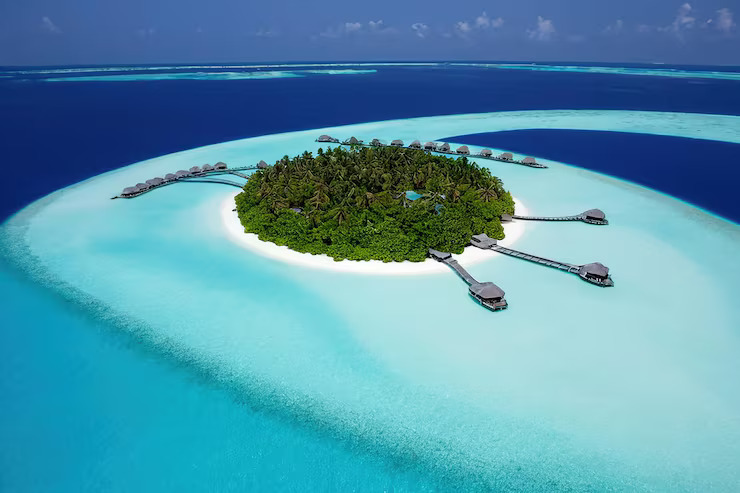
SATV Kathmandu Oct 31: As the climate crisis intensifies, certain islands around the world are becoming increasingly uninhabitable due to a combination of rising sea levels, extreme weather events, and environmental degradation. These changes are not just theoretical but are already being felt by local communities, and by 2026, many islands may be facing imminent threats that could make them uninhabitable for travelers and residents alike. From small Pacific nations to Arctic territories, the effects of climate change are pushing these islands to their limits.
Tuvalu: A Sinking Nation
Tuvalu, a small island nation in the Pacific Ocean, is perhaps the most emblematic example of the consequences of rising sea levels. The country’s highest point is only 4.5 meters above sea level, making it extremely vulnerable to flooding. Climate change models predict that by 2050, over 90% of Tuvalu’s land could be submerged. While the Tuvaluan government has been proactive in seeking international support and has even embarked on a digital nation project to preserve the nation’s cultural identity in the event of physical displacement, the reality is that flooding and storm surges are already disrupting daily life. This island’s future seems bleak, as rising sea levels continue to encroach on its land.
The situation is urgent, and without immediate global action to curb greenhouse gas emissions, the nation may soon become entirely submerged. Travelers visiting Tuvalu are already facing disruptions, and the prospect of visiting in the near future may become a matter of history, rather than a living destination.
Source: The Guardian
The Maldives: A Paradise at Risk
The Maldives, located in the Indian Ocean, is another island nation that faces an uncertain future. Like Tuvalu, the Maldives is extremely low-lying, with much of its land being just a few meters above sea level. Rising sea levels pose an existential threat to the nation’s over 1,000 islands. The Maldives has already experienced extensive coral reef degradation, which previously acted as a natural barrier against storm surges.
Projections suggest that by 2050, over 80% of the Maldives’ land could be uninhabitable. With its famous resorts and beaches, the Maldives is a key destination for global tourism. However, with the loss of coral reefs and the constant threat of storm surges, many tourist spots may become unreachable or destroyed altogether in the coming years. The local government has already started to explore relocation options and adaptation strategies, but the clock is ticking.
The island nation has become a symbol of the potential future of many low-lying nations as climate change worsens. For tourists planning a trip to the Maldives, this situation raises questions about how long the islands will be safe for visitors.
Carteret Islands: A Struggle for Survival
The Carteret Islands, part of Papua New Guinea, are in an even more precarious situation. The islands sit just 1.5 meters above sea level and have already experienced severe coastal erosion and saltwater intrusion. As a result, agricultural land is becoming increasingly less fertile, and freshwater sources are being contaminated by saltwater. The islands’ residents have already started to migrate to nearby Bougainville, but the process has been slow, and many families have lost their homes.
The Carteret Islands are one of the first communities to experience the reality of becoming climate refugees, and their fate is a dire warning of what awaits other small island nations in the future. While efforts to relocate populations are ongoing, they are hampered by limited resources and global climate action. By 2026, the islands may no longer be able to support any form of human habitation, making them uninhabitable for both locals and travelers alike.
Fiji: Rising Waters and Relocation Efforts
Fiji, located in the South Pacific, is also grappling with the consequences of climate change. The country is home to over 300 islands, and many of its coastal villages are now at risk due to rising sea levels. Villages like Muani are being forced to relocate inland as their homes are being increasingly inundated by flooding and storm surges. However, relocation efforts have been slow, hindered by both financial constraints and the complexity of moving entire communities.
Fiji’s situation is not unique in the Pacific; other nations in the region are facing similar challenges. The island nation is an example of how climate change is not just an environmental issue, but also a humanitarian crisis. The threat to its tourism industry is also significant, as resorts in low-lying areas may become vulnerable to coastal flooding. By 2026, many areas of Fiji may be no longer viable for both residents and tourists due to environmental threats.
Source: Washington Post
Svalbard: A Rapidly Changing Arctic
Svalbard, a group of islands in the Arctic Ocean, is facing a different but equally severe threat. This region is experiencing warming at rates five to eight times faster than the global average, making it one of the most rapidly changing environments on Earth. Permafrost is rapidly thawing, leading to infrastructure instability and increased risks of avalanches and landslides. These conditions are making the islands increasingly dangerous for both locals and tourists.
Svalbard’s ecosystem is also being impacted by melting glaciers, and species such as polar bears, which rely on sea ice, are facing severe challenges. The future of tourism in Svalbard is uncertain, as travelers to the Arctic may no longer have access to the same landscapes or experiences. The region may be forced to adapt or restrict access due to the hazards presented by a warming climate.
Source: Le Monde
A Global Challenge
These islands exemplify the severe challenges posed by climate change, with rising sea levels, extreme weather events, and environmental degradation threatening not only the local populations but also the tourism industry that many islands rely on for their economies. As the world races against time to mitigate climate change, the fate of these islands may become a stark reminder of the urgency of addressing global warming. By 2026, many of these islands may become uninhabitable for both residents and travelers, marking a tragic milestone in the fight against climate change.












